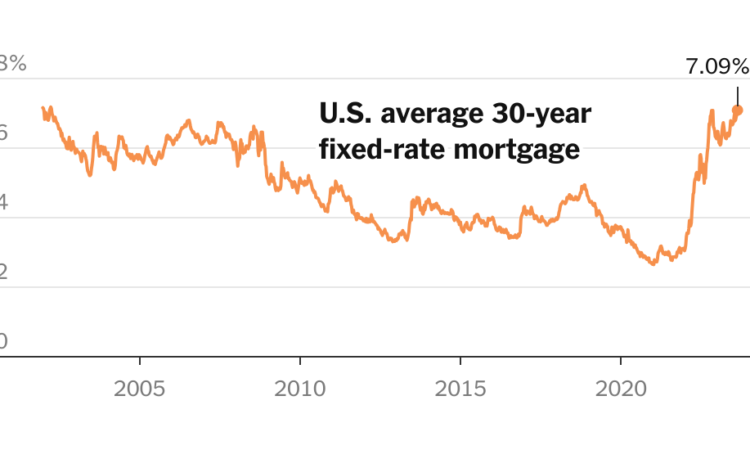
Mortgage rates jumped to a 21-year high this week, climbing back above 7 percent and making it even harder for buyers to afford homes in an already difficult market.
The average 30-year fixed-rate mortgage — the most popular home loan in the United States — was 7.09 percent, up from 6.96 percent last week, Freddie Mac said on Thursday. A year earlier, the 30-year rate was 5.13 percent.
The current rate is the highest since April 2002. In the intervening period, home buyers enjoyed years of falling rates, which even dipped below 3 percent at the beginning of the pandemic.
But as rates abruptly surged, the housing market has been mired as owners are unwilling to put their homes on the market because they feel locked in by the low rates on their existing mortgages.
In June, sales of existing homes fell nearly 19 percent from the year before, according to the National Association of Realtors. The median price of an existing home was $410,200 in June, the second-highest since the organization began tracking the data in 1999, down only marginally from a high of $413,800 a year ago.
“The new reality has jolted the housing market: Home sales have fallen sharply since 2021, and homeowners, reluctant to give up their super-low mortgage rates, are staying put,” Jeff Ostrowski, an analyst at the personal finance company Bankrate, wrote in a note. “Housing affordability has emerged as a persistent challenge.”
The lack of existing homes has pushed buyers to consider new construction. The sale of new homes climbed nearly 24 percent in June from the same period a year earlier, the Census Bureau reported. Housing starts, a measure of the construction of new homes, increased about 6 percent in July from the previous year.
But for home buyers, finding affordable options remains difficult. The Federal Reserve has lifted its policy interest rate, which underpins borrowing costs across the economy, to the highest level in 22 years as it tries to cool the economy and slow stubbornly high inflation.
Officials at the central bank have forecast one more rate increase this year. They expect to cut rates next year, but they think it could be several years before rates return to the lower levels that were common before the pandemic.
Mortgage rates generally track the yield on 10-year Treasury bonds, which are influenced by a variety of factors, including expectations around inflation, the Fed’s actions and how investors react to all of it. On Thursday, the 10-year yield rose above 4.3 percent for the first time since 2007.






